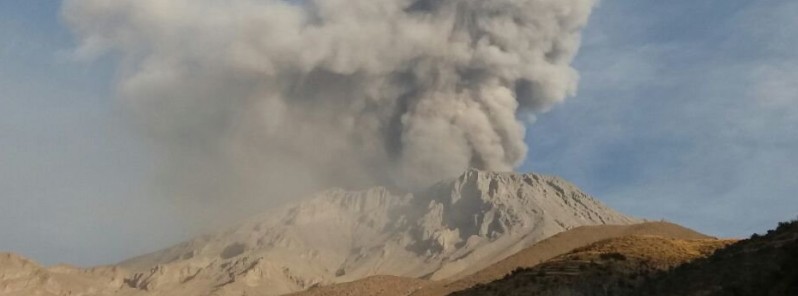Ubinas starts erupting after 9 months of calm, Peru

After almost 9 full months of calm, Peru's Ubinas volcano has started erupting again on October 3, 2016 (October 2, local time). Although volcanic ash is not identifiable by satellites, weak emissions of steam and gases were observed by webcams. Aviation color code for the volcano is set on Orange.
According to the reports, the most energetic explosion so far occurred at 03:50 UTC on October 3 (22:50 PET on October 2), measuring at 19 megajoules, just three hours after the first exhalation happened at 00:21 UTC (19:21 PET) at 0.6 megajoules.
The eruptions has already caused ash coverage in the town of Ubinas, southeast of the crater, and northeastern villages of Santa Rosa de Phara and Yanapuqui.
Authorities warned of possible reoccurrence and to take proper measures.
The previous eruption at Ubinas occurred on January 16, 2016. It was followed by a gradual decrease of activity during the first half of the year. Seismicity started to pick up in June and further increased on September 9.
#volcan #volcano #Ubinas grosse émission de cendres hier soir/Strong ash emission yesterday evening pic.twitter.com/ZdBQR8CREz
— CultureVolcan (@CultureVolcan) October 4, 2016
#LoÚltimo Nueva explosión en el volcán #Ubinas a las 17:13 horas. Lea y descargue la alerta de dispersión de ceniza. https://t.co/17DjVZrp3j pic.twitter.com/v7uX1xp2ou
— IGP (@igp_peru) October 3, 2016
Geological summary
A small, 1.4-km-wide caldera cuts the top of Ubinas, Peru's most active volcano, giving it a truncated appearance. It is the northernmost of three young volcanoes located along a regional structural lineament about 50 km (31 miles) behind the main volcanic front of Perú. The growth and destruction of Ubinas I was followed by construction of Ubinas II beginning in the mid-Pleistocene. The upper slopes of the andesitic-to-rhyolitic Ubinas II stratovolcano are composed primarily of andesitic and trachyandesitic lava flows and steepen to nearly 45 degrees. The steep-walled, 150-m-deep (492 feet) summit caldera contains an ash cone with a 500-m-wide (1 640 feet) funnel-shaped vent that is 200 m (656 feet) deep.
Debris-avalanche deposits from the collapse of the SE flank about 3700 years ago extend 10 km (6.2 miles) from the volcano. Widespread plinian pumice-fall deposits include one of Holocene age about 1000 years ago. Holocene lava flows are visible on the flanks, but historical activity, documented since the 16th century, has consisted of intermittent minor-to-moderate explosive eruptions. (GVP)
Featured image: Ubinas volcano erupting on October 3, 2016. Credit: Melquiades Alvarez (via Twitter)

Commenting rules and guidelines
We value the thoughts and opinions of our readers and welcome healthy discussions on our website. In order to maintain a respectful and positive community, we ask that all commenters follow these rules.